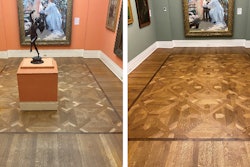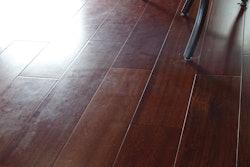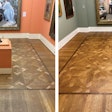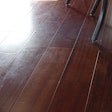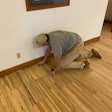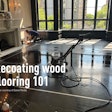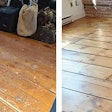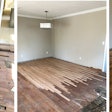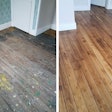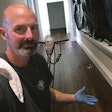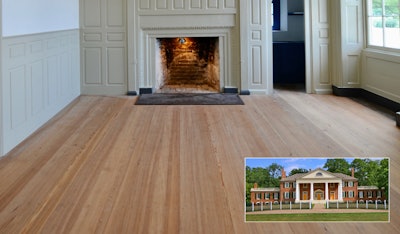
 Here I am working on cleaning the wood floors at Montpelier.
Here I am working on cleaning the wood floors at Montpelier.
This interest has provided me and my two (wood flooring contractor) brothers some pretty interesting stories for our "rocking chair chats." To date, we have been involved in some of the most challenging and high-profile wood floor restoration projects in the country. They include some of the extravagant homes of 19th century industrialist elites and, more recently, Montpelier, the home of James Madison. I now find myself looking at restoring part of a 170-year-old plantation, complete with slave quarters. I couldn't be happier.
However, don't let me paint too rosy a picture. Restoring old wood floors can be frustrating and costly, and sometimes you find yourself working with a homeowner who redefines "zealot." As a former math teacher, I will tell you that there are more variables in restoring wood floors than Algebra I and II combined. Over time, I have tried to identify these flash points and take the appropriate actions. Let me share a few insights.
Inspection and Sampling
You start with an on-site visit that is far more involved than the cursory walk-through you would give most homes. I make sure the potential client knows this and charge them for my time. I go armed with my digital camera (sometimes a camcorder) and shoot pictures like a doting grandparent. I want to capture anything that my eyes (and experience) see that might be an issue or need explaining in the future. What might that be? Some pre-existing conditions I have found include: oil stains where previous tenants had worked on their motorcycle (in the living room), axe marks left in the floors where firewood was being split, gunshot holes, knife marks from a daredevil game called "mumblety peg" and countless compression scars where pianos and other heavy furniture were pushed over the floors. You will find that later in the project many homeowners develop selective memory ("I don't remember those marks"), and being able to e-mail them images you documented proves invaluable.
I also take samples of the wood just in case I need a proper ID. You would be surprised how often the wrong species or mill cut is used when replacement wood is needed.
I make sure that I take a small area (maybe an 18-inch square) and actually try removing whatever is on the floor. This gives me a chance to time how long it takes, and this information will go a long way in putting my proposal together.
And, let's not forget the usual suspects in an old home: lead paint and asbestos. The tests for these are relatively simple and you better pay attention to them. A lot of attorneys live well off of litigating these types of contamination.
The Loss of Original Material
How much wood is lost in the restoration of wood doors, wood windows, wood trim, wood paneling? None. But in "restoring" an old floor that has several layers of old finish or paint, you could easily lose 30 percent of the wear surface of the wood just because you were too aggressive in the sanding. Compounding this is the fact that many of these wood floors have already lost considerable wood from previous sandings. It is a little tough to say you are "restoring" something when a lot of it is on the street in trash bags. This fact is not lost on preservationists.
There are other options for removing layers of finish without losing so much wood. There are a lot of what I call "secondary" sanders available today that aren't as aggressive. The work will take longer and you will go through much more paper, so be prepared to explain that at your client meeting and show those costs in your proposal. I have gotten to the point that I don't even bring my big machine and edger to the job site. All work is done by the secondary sanders or even less.
The Disclaimer and Discovery Phase
Many people who restore old homes have a skewed view of what is involved. They surround themselves with books, articles, and DVDs, and they watch DIY shows out the yazoo. Building supply giants offer courses to DIY homeowners, convincing them that the last thing they want to do is pay good money for seasoned and experienced labor. Most of the time, this information comes from people who are much better at writing or filming than they are at actually doing the work. The term "jack of all trades, master of none" probably finds its origins with these well-intentioned folks.
I have found that the best approach is to make sure I am well-prepared when I meet with these individuals. I cannot overemphasize how important a referral list can be at this point. People who restore old homes love to talk to others who have done the same. Being able to connect your potential client with a previous client will do wonders at putting their mind at ease.
You are also dealing with a group who does not like to be dictated to. I am patient with my explanations and confident enough with what I am doing that if I am challenged, I don't feel like I am backed into a corner. Being a good listener, exercising some patience and doing a little hand-holding has worked well for me.
Once the work begins, don't be surprised if you make discoveries that were not apparent prior to starting.
Once the work begins, don't be surprised if you make discoveries that were not apparent prior to starting. Paint and heavily discolored finishes can completely obscure damage or items that can create some serious issues. (My favorite was when I sanded paint off a pine floor and uncovered a scorched area that had the eerie shape of a human torso. The husband had me replace the wood pronto as he was sure his wife would have a "for sale" sign in the yard—she had never wanted to buy the old house in the first place!) I try to keep a set of digital images in my computer that covers most of the situations you might uncover. I am known for providing a lot of information and, although it might seem like overkill at times, it has never come back to bite me.
In summarizing, I am reminded of a recent car commercial: "This isn't your father's Oldsmobile." These are not your normal wood flooring projects, and the sooner you treat them that way, the more you will learn and the more enjoyable they will be.
Also by Michael Purser:
The Low-Hanging Fruit: Old Floor Refinishing
The Floor Listener: Wood Floors Have Stories to Tell
What the Wood Flooring Industry Can Learn From the Tower of Babel
















